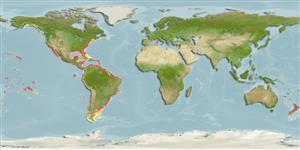Pycnogonida |
Pantopoda |
Ammotheidae
Environment: milieu / climate zone / depth range / distribution range
Ecology
Benthic; depth range 0 - 72 m (Ref. 116112). Subtropical
Western Atlantic and Pacific Ocean.
Length at first maturity / Size / Weight / Age
Maturity: Lm ? range ? - ? cm
Trunk robust, compact, with 2 tall median tubercles about as long as abdomen, each with lateral and posterior spines. Ocular tubercle more than half as long as trunk tubercles. Lateral processes moderately long, separated by less than their diameters, with low dorsodistal and laterodistal spinose tubercles. Abdomen long, distally downcurved, with short proximal, median, and distal spinose tubercles. Proboscis very inflated. Chelifore scapes 2 segmented; first segment very short, second almost 4 times longer, with short median and distal spinose tubercles; chelae bulbous, vestigial. Oviger fifth segment almost as long as fourth; terminal segment tiny, with 2 setae. Legs with many dorsal and lateral spinose tubercles only slightly longer than segment diameters; propodus well curved, with marked heel bearing 3 spines (Ref. 2115, p. 31).
Shallow habitats (Ref. 2115, page 31). Found on bay and nearshore. Epibiotic (Ref. 116112).
Life cycle and mating behavior
Maturity | Reproduction | Spawning | Eggs | Fecundity | Larvae
Members of the class Pycnogonida are gonochoric and sexually dimorphic. During copulation, male usually suspends itself beneath the female. Fertilization occurs as the eggs leave the female's ovigers. Males brood the egg masses until they hatch. Life cycle: Eggs hatch into protonymphon larva then to adults.
Child, C.A. 1996 The Pycnogonida types of William A. Hilton. II. The remaining undescribed species. Proceedings of the Biological Society of Washington 109(4):677-686. (Ref. 2117)
IUCN Red List Status
(Ref. 130435: Version 2025-1)
CITES status (Ref. 108899)
Not Evaluated
Not Evaluated
Threat to humans
Human uses
| FishSource |
Tools
More information
Trophic EcologyFood items (preys)
Diet composition
Food consumption
Predators
Population dynamicsGrowth
Max. ages / sizes
Length-weight rel.
Length-length rel.
Length-frequencies
Mass conversion
Abundance
Life cycleReproductionMaturityFecunditySpawningEggsEgg developmentLarvae PhysiologyOxygen consumption
Human RelatedStamps, coins, misc.
Internet sources
Estimates based on models
Preferred temperature
(Ref.
115969): 23.1 - 28.3, mean 27.1 (based on 404 cells).
Price category
Unknown.
